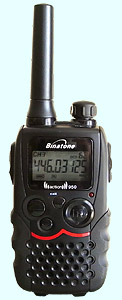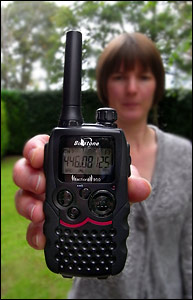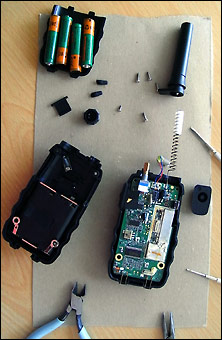A mini review of the Binatone Action 950 Walkie Talkie PMR446
Two Way Radios
Our 2003 purchased Private Mobile Radio (PMR446) walkie
talkies were getting a bit tatty so we replaced them with the Binatone
Action 950 two way radios. Here's our review...
Also: PMR446
website links
Other product reviews | Smartphone | Android Apps | Digital Camera | GPS
Sat Nav receiver | DV Camcorder | Talkie Walkies
 This review
assumes a basic understanding of the appropriate technology. This review
assumes a basic understanding of the appropriate technology.
Reviewed October 2010 + updates below.
This page should now be considered an archive resource (although the
principles may still apply).
We did some research and these licence free PMR446 two way
radios looked promising. Essentially a parallel replacement with
a more professional appearance and a (reported) better communication
range, we were convinced when we found we could get them for 'free' by
using up some loyalty card points.
Like our previous talkie
walkie radios, the Binatone Action 950 batteries (NiMh cells this
time) are recharged by conveniently slotting into a charging
'pod'. Unlike their predecessors no plug-in earphone / mic is
supplied (although the MR600 ones work fine). Some new features
are present, such as a vibrate call alert, new call ring tones and a
(thankfully switch-able) roger beep.
On the right. The professionally
styled Binatone Action 950 two way radio handset.
Testing the range
The first thing we did was to see how far we could communicate using
the Binatone Action 950's. We also compared the new two way
radios with the old talkies. To do this Belinda sat at home
supping wine in the lounge with one old and one new radio set to
different channels, while Mike went walkabout (without wine) also armed
with one of each. He called up from seven pre-determined points
on each talkie in turn and back home Belinda logged the results (and
supped some more wine). The terrain was semi-rural, and obstacles
included: housing, a railway line, a pub, some shops, a car park, and
some green open space. Oh yes, let's not forget the trees and
gradually rising then dropping elevation. Oh, and the lounge wall
and window!
It soon became apparent that the new two way radios were more
capable than the old walkie talkies, which started to break-up at
around the railway, 1/3rd mile away. The 950's became patchy soon
after, but in general communication was still possible right up to
point 7 at almost one mile distant, long past point 3 when the old
radios gave their last gasp.
While a mile may not sound too good, especially considering
the advertised range of 'up to 6 miles in ideal conditions' we were
operating these two way radios in far from ideal conditions. As
both walkie talkies are constrained by the regulated PMR446
licence-free transmit power of ½ watt ERP, we put the improved range
down to better aerial efficiency and receiver sensitivity.
Now of course this was a far from reliable scientific range
test (especially as wine was involved!) but it proved the Binatone
Action 950 PMR446 radios did indeed have an improved comms range.
As we've found previously, the biggest obstacle to two way radio range
is land mass; here we had that getting in the way so not a bad result
overall.
And did Mike make it back to base? Yes, much later -
after he diverted to the pub for a 'swift' half!
 Other good points then? Other good points then?
Apart from the comms range then, what else is better on the Action
950's? Well, for one these talkies can stand upright without
falling over (the old ones had a rounded base) and your hand fits
snugly round the molded casing. Watch out when standing the
radios vertically on metal objects though as the battery charge
contacts are flush on the base - could cause some arky-sparky!
Remember the CTCSS codes in the original
talkie walkie review? The Binatone 950's have CTCSS but also
add DCS (Digital Code System) - 85 DCS codes in fact - for extra comms
security. And settings allow the radio to scan received
transmissions for CTCSS / DCS codes being used. Another useful
setting allows two channels only to be scanned (dual watch) in addition
to scanning all eight (auto channel scan). We often need to scan
channels 2 & 8 when out geocaching.
Any not so good points?
Yes, a few! Firstly, the Binatone two way radio's rotatory
volume/on-off control doesn't have click stops or markings and, with
its light touch, it's very easy to inadvertently knock it down with the
result no calls are heard. We added a white stripe (there's life
after typewriters for correction fluid!) to the knob to determine
position. Another gripe with the radio's volume is the lack of
it, even turned up full; OK indoors, but not when outside. It
would be inaudible in a noisy workshop, building site or even the pub,
for instance (so that's why Mike didn't hear Belinda frantically
calling when returning from our range test!) Then there's the
pointlessly prominent large frequency readout digits on the LCD
display; with only eight channels users just don't need to know this -
TMI - and it's bound to cause confusion, a large channel number would
be far more useful. One last point: although there's a lock to
prevent accidental channel/code changes, the lock doesn't work when
scanning and it's all too easy for a button to get pressed unknowingly
and stopping the scan.
These issues are a real shame, particularly when they'd
probably been an easy fix at the design stage at negligible cost.
|
Good Points...
|
Bad Points...
|
- Can stand it up vertically
- Improved range
- DCS security codes
- Channel/CTCSS & DCS combinations stored
|
- Volume control undetermined position
- Silly frequency readout prominence
- Button lock inoperable when set to scan
- Scanning for CTCSS / DCS codes laboured
|
We'll let you know how the Binatone Action 950 PMR446 two way
radios are fairing in about a year's time...
Update Oct 2011, looking good
Not a lot to report really, the Binatone Action 950 two way radios work
just fine still. We've dropped them a few times and they've
survived and, like our previous talkie walkies, there's a bit of dust
build-up under the perspex display but it's no bother. We've
noticed the transmit audio is lower on one talkie and keep meaning to
pop the cover off to see if the mic has dislodged (maybe one of the
drops?) but haven't yet. And we find the squelch (the circuit
that cuts the background hiss under no signal conditions) seems to be
set a little too high, causing the received signal to chop out when,
although marginal, is still intelligible. If it wasn't for this
the usable range of these two way radios would be extended a
little. The squelch can be overridden with a press of a couple of
buttons, but then the noise roars until cancelled which is a bit of a
faff. So maybe another reason to pop the cover off the Binatone
Action 950's and get to the guts to see if there's a squelch pre-set on
the circuit to tweak. We should add that Mike's background
was in electronics and radio communication; don't try this if you're
not familiar with micro-electronics! And of course it'll
invalidate any warranty still current.
Update Oct 2012 - not so good
 In last year's update we were
pondering on opening up these PMR446 two way radios to investigate the
low transmit (TX) audio one of the pair was producing. Well, we
did and after a bit of internet research identified two 'pots' (that's
a technical term for a miniature circuit board adjuster according to
Mike; definitely not something he engaged in during his youth!) - one
for squelch and other for deviation (yes, another rather technical term
that sort of governs the transmit sound). After carefully marking
the existing position of these pots, we first twiddled the squelch to
allow a weaker signal to be received before noise cut-off.
Subsequent testing found that this did indeed increase the range, at
the expense of a noisier signal (voice) at the edge of range. In last year's update we were
pondering on opening up these PMR446 two way radios to investigate the
low transmit (TX) audio one of the pair was producing. Well, we
did and after a bit of internet research identified two 'pots' (that's
a technical term for a miniature circuit board adjuster according to
Mike; definitely not something he engaged in during his youth!) - one
for squelch and other for deviation (yes, another rather technical term
that sort of governs the transmit sound). After carefully marking
the existing position of these pots, we first twiddled the squelch to
allow a weaker signal to be received before noise cut-off.
Subsequent testing found that this did indeed increase the range, at
the expense of a noisier signal (voice) at the edge of range.
However we weren't so lucky with the quiet TX audio.
First we cut out some of the foam around the microphone (mic) hole in
the radio's case, then drilled out said hole a bit larger, but both
showed no improvement. Next we checked for a dry joint on the
board, running over some with a soldering iron. Again, no
fix. So we twiddled the deviation pot and the only effect was an
increase in background noise (deviation isn't really the right area,
but it was worth a shot) so we quickly returned it to the position we'd
marked. Not to be easily beaten we next figured it might be a
duff (now that's not a technical term!) mic insert, so desoldered it
and replaced with the one in the unused mic/earphone harness that came
with our previous talkie walkies. Arrggh, still no change (it's
enough to drive you back to pot)! And so it remains, our
conclusion is a faulty component on the circuit board.
Our two way radio in bits. Can we
fix it? Er, no!
We've had several enquiries from you guys out there about
battery life and how they're holding up. Well, yes, they have
noticeably dropped in running time so we've replaced the
batteries. The Binatone Action 950's were supplied with 8 AAA
rechargeables of only 550mAh capacity and we've now got some high
quality branded 1000mAh, after all they're cheap enough. We
changed to using a separate charger that stops the charge when fully
charged; this avoids over-charging and cooking the batteries, although
we lose the convenience of slotting the two way radios into their
charging dock. But batteries are now rather academic for us as
the unresolved low TX audio on one radio rather render it useless so
we're looking for some new ones... Two way radios that is.
And we'll probably spend a bit more and get some more robust ones -
taking them apart revealed just how down-to-a-price these are made!
Update Mar 2014 - a possible solution, then again...
Well you never know who's lurking, and following our previous Binatone
Action 950 update (above) we were soon contacted by one of you
genned-up guys out there (thanks Dave, you know who you are). Now
Dave suggested a possible cause and cure for our low level TX audio on
one of the two way radios - that the channel frequencies may have
drifted (as they had on his Action 950) and that there's an adjuster
for that. So it was off with the casing of the offending talkie,
adjuster identified and a twiddle with a frequency meter attached
and... no difference - arrggh! Of course the short soldered
speaker wires dropped off again (we fitted longer ones re-routed to
minimise strain when we next open up these two way radios, if we ever
do).
The Binatone Action 950 has now been superseded twice over,
first by the Binatone Action 1000 and currently Binatone Action
1100. But don't get too excited - it appears these are cosmetic
changes only, with the same radio 'guts' under the hood. So we
won't be buying them anytime soon; there's our TX audio problem, but
the main reason is that our delving in revealed just how skimpily made
these two way radios are.
Pending any major developments, this will be our last Binatone
Action 950 talkie walkie review update. For the record, this two
way radio review page is among the most visited and sees the longest
average time-on-page of our site. So... thanks for watching, and
goodnight.
See PMR446 talkie
walkie related website resources and the Binatone website on our
earlier review page.
© micbinks 2010-2014. Please ask permission if
you wish to reproduce any of our content.
|
